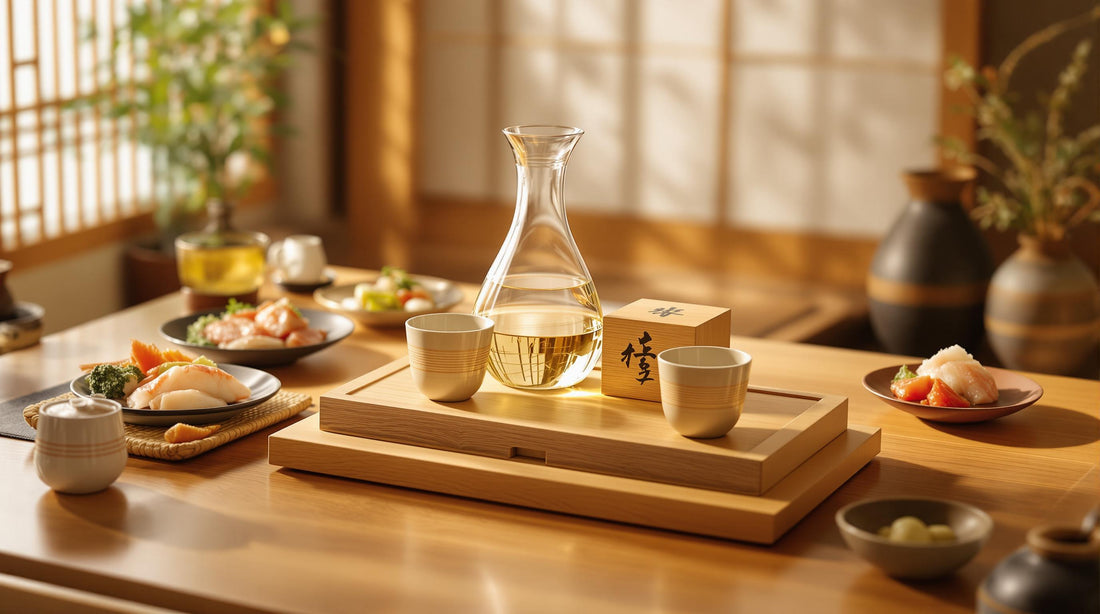
Junmai Sake Flavor Profiles Explained
Share
Junmai sake is made with just rice, water, yeast, and koji mold, offering three main types with distinct flavors:
- Basic Junmai: Full-bodied with strong umami and acidity. Pairs well with grilled meats, stews, and fried foods.
- Junmai Ginjo: Balanced and aromatic with fruity and floral notes. Great with sashimi, tempura, and light fish dishes.
- Junmai Daiginjo: Light, complex, and elegant with tropical fruit flavors. Best enjoyed with delicate seafood or on its own.
Quick Comparison
| Type | Rice Polishing Ratio | Key Traits | Best Pairings |
|---|---|---|---|
| Basic Junmai | 70% | Rich, umami, bold | Grilled meats, fatty dishes |
| Junmai Ginjo | 60% | Balanced, fruity, floral | Sashimi, tempura, light fish |
| Junmai Daiginjo | 50% or less | Light, complex, highly aromatic | Delicate seafood, soft cheeses |
Each type’s flavor depends on factors like rice polishing, brewing techniques, and water quality. Whether you prefer bold or refined tastes, Junmai sake offers options for every palate and pairing.
Understanding Daiginjo and Junmai Daiginjo Sake Differences
1. Basic Junmai
Basic Junmai sake showcases the essence of its ingredients and the brewing traditions of its region, offering a foundation for more refined styles.
Its flavor profile is defined by three key traits: a strong umami presence, noticeable acidity, and a rich, textured mouthfeel. The umami comes from higher levels of amino acids like glutamic acid[3], while the use of less-polished rice contributes to its full-bodied texture[9]. Serving temperature plays a big role in shaping its taste: chilling highlights its acidity, while warming it to 45°C (113°F) brings out deeper umami and richer flavors[9].
This sake's bold rice flavor and earthy, mineral undertones make it an ideal match for:
- Grilled meats and fatty fish
- Hearty stews and aged cheeses
- Mushroom-based dishes and fried foods
Its full-bodied nature balances rich, savory flavors while enhancing the taste of complementary ingredients[9][4]. These qualities make Basic Junmai a highly adaptable style, perfect for pairing with a variety of dishes before diving into the more aromatic world of Ginjo sake.
2. Mid-Grade Junmai Ginjo
Junmai Ginjo takes things up a notch from Basic Junmai, offering a more refined and aromatic experience [1][2]. Its purity gives it a lighter, more fragrant profile [1][2].
This sake strikes a balance between subtle umami and vibrant fruit and floral notes [3]. Expect flavors like fresh apple, pear, and melon, often paired with delicate floral hints such as cherry blossom and jasmine [1][2].
One standout feature is its Sake Meter Value (SMV), typically ranging from +3 to +5. This indicates a slightly dry to dry taste, creating a sophisticated balance:
| Flavor Component | Characteristic | Impact on Experience |
|---|---|---|
| Sweetness | Refined, subtle | Gives a clean finish |
| Acidity | Lower than Basic Junmai | Enhances smoothness |
| Texture | Silky, medium-bodied | Highlights nuanced flavors |
| Umami | Subtle, balanced | Complements without overwhelming [3] |
Serving temperature plays a big role in how Junmai Ginjo tastes. The ideal range is 10-15°C (50-59°F), which keeps its delicate aromatics intact while preserving a balanced texture [6]. Chilling it emphasizes fruity notes, while slightly warmer servings bring out complex rice flavors.
Its balanced nature makes it a great match for lighter dishes like fresh sashimi, vegetable tempura, or grilled white fish.
Junmai Ginjo is crafted through a low-temperature, extended fermentation process, achieving a level of sophistication that bridges the gap between Basic Junmai and the ultra-refined Junmai Daiginjo [6].
3. Premium Junmai Daiginjo
Junmai Daiginjo takes the refinement of Junmai Ginjo to the next level, focusing on precision and elegance. With a minimum rice polishing ratio of 50%, this sake achieves a clean, pure flavor profile through carefully controlled brewing methods[2].
The extended low-temperature fermentation process, combined with the 50% rice polishing, creates complex aromas of melon, lychee, and cherry blossom. These are complemented by subtle honeyed notes and a gentle umami presence[1][2][3].
While Junmai Ginjo balances subtlety and structure, Junmai Daiginjo leans into its delicate complexity. A great example is the Amabuki Kimoto Omachi, polished to 40%, offering a harmonious SMV +1 profile with tropical fruit flavors[7].
Its silky texture and light body are achieved through specialized pressing techniques that preserve its fragile characteristics[3]. This sake pairs beautifully with fresh sashimi, light seafood dishes, or soft, creamy cheeses, enhancing their flavors without overpowering them[1][2][3].
Junmai Daiginjo represents the pinnacle of the Junmai category, moving from the robust versatility of basic styles to the crystal-clear purity of this premium offering, which demands equally refined food pairings.
sbb-itb-d9fb1bc
Production Methods and Local Effects
Junmai's unique flavors come from both its brewing techniques and the local environment. The Kimoto and Yamahai brewing methods, which use natural lactic acid bacteria, play a key role in shaping its taste. These traditional processes influence the balance of sweetness, acidity, and umami that defines Junmai. For instance, Yamahai brewing often results in bold flavors with noticeable acidity[1][2].
Water, making up about 80% of the final product, is another critical factor. Its mineral content impacts both fermentation and flavor. In Kyoto's Fushimi district, soft water leads to light, delicate sakes. On the other hand, the Nada region in Hyogo prefecture, known for its harder water, produces sakes that are dry and crisp[3][5].
Here’s a quick comparison of how production methods and water types influence Junmai:
| Method | Water Type | Flavor Profile | Notable Example |
|---|---|---|---|
| Kimoto | Soft | Earthy, rich texture | Daishichi Kimoto Junmai |
| Yamahai | Hard | Bold, high acidity | Terada Honke Traditional |
Fermentation temperature also shapes the final style. Cooler temperatures (around 10°C) result in clean, aromatic sakes, while warmer fermentation (15–18°C) produces fuller-bodied varieties with pronounced rice flavors[3].
Post-fermentation processes further refine the sake's character. Coarse filtration, which leaves some rice particles, adds body and texture, while fine filtration creates a cleaner, more polished taste profile[5].
Strengths and Limitations
Each Junmai category has distinct characteristics that influence its flavor and use. Basic Junmai is known for its bold flavors and versatility. Its higher acidity and strong umami make it a great match for rich dishes, and it works well across a range of temperatures, from chilled to warm[1][3].
Junmai Ginjo offers a refined yet approachable profile. With its lighter body and aromatic qualities, it appeals to those familiar with lighter wines. The 60% rice polishing ratio enhances its fruity and floral notes, though this refinement comes at a higher cost[2].
Junmai Daiginjo showcases the peak of sake craftsmanship. Its delicate flavors make it ideal for special occasions, but they can be overshadowed by strong, bold dishes.
Here’s a quick comparison of the three Junmai types:
| Characteristic | Basic Junmai | Junmai Ginjo | Junmai Daiginjo |
|---|---|---|---|
| Umami Intensity | High | Medium | Low |
| Layered Flavors | Rich, straightforward | Balanced, refined | Highly complex |
The choice between these types often depends on the occasion and food pairing. Basic Junmai’s strong umami works well with casual meals, while Junmai Daiginjo’s subtlety is best appreciated on its own or with light dishes[2][8].
Conclusion
Exploring the flavor profiles of Junmai sake can help enthusiasts find options that match their taste preferences and dining experiences.
Basic Junmai is a great starting point for those who enjoy bold and rich flavors. Its higher acidity levels, typically between 1.0 and 2.0[7], combined with strong umami notes[1][2], make it a versatile choice for pairing with hearty, flavorful dishes.
Junmai Ginjo strikes a balance between traditional and refined. With its fruity and floral aromas, it still retains enough depth to complement a variety of cuisines[2]. This category has become increasingly popular worldwide, appealing to those who value aromatic and premium sake.
Junmai Daiginjo represents the pinnacle of craftsmanship. Its delicate and intricate flavors are best enjoyed on their own or paired with light dishes like fresh oysters or other subtle seafood options[7].
These distinctions are rooted in the brewing techniques discussed earlier, where factors like rice polishing and fermentation directly influence the acidity and aroma. The pairing suggestions highlight how each type's unique structure – from the umami-rich Basic Junmai to the refined Junmai Daiginjo – aligns with specific culinary experiences.
Regional traditions and brewing methods also add distinct character to each Junmai style[8][10]. Whether you're planning a casual meal or a formal gathering, Junmai sake offers tailored options to suit different occasions and flavor preferences.
FAQs
What is the flavor profile of Junmai?
Junmai offers a range of flavors, but it consistently highlights a balance of umami, acidity, and a rice-forward taste. Basic styles lean toward an earthy richness (1.3-1.7 acidity)[8], while higher grades bring out more subtle and layered flavors. Traditional brewing methods like Yamahai can amplify umami and acidity[2], and the mineral content of the water (soft or hard) influences the texture and finish[7]. Serving temperature recommendations depend on the specific category.
These differences reflect the unique traits of Basic Junmai, Junmai Ginjo, and Junmai Daiginjo, illustrating how production techniques shape each type's flavor.
